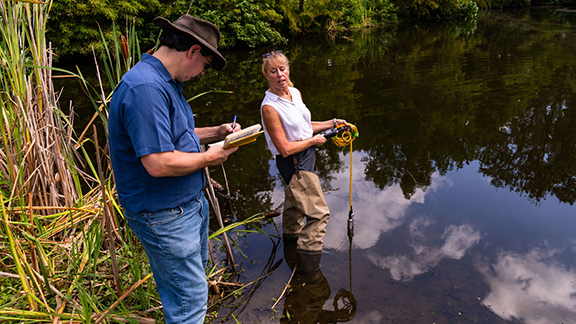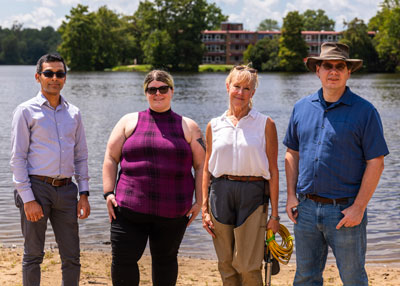by Tim Crosby
CARBONDALE, Ill. – A team of researchers at Southern Illinois University Carbondale is working on a new technology aimed at ordering a common water algae that produces a toxin to knock it off.
The team of faculty researchers from the School of Biological Sciences, which includes Scott Hamilton-Brehm, Marjorie Brooks and Lahiru Jayakody, recently received a one-year $194,000 grant to pursue the research on mitigating harmful algae blooms (HABs) using a molecular technique. The grant will fast-track development of a delivery mechanism for a patent-pending molecular biology solution for managing HABs.

Scott Hamilton-Brehm, left, and Marjorie Brooks, both associate professors in the School of Biological Sciences, take measurements at Campus Lake. The two SIU researchers are part of a team working on a technology to mitigate harmful algae blooms. Below: A team of SIU researchers in the School of Biological Sciences working on a new technology for mitigating harmful algae blooms includes, left to right: Lahiru Jayakody, assistant professor; Hannah Phillips, paraprofessional; Marjorie Brooks, associate professor; and Scott Hamilton-Brehm, associate professor.
The grant, which starts Nov. 1, is from the United States Harmful Algal Bloom Control Technologies Incubator, a partnership among the National Oceanic and Atmospheric Administration (NOAA), the University of Maryland’s Institute of Marine and Environmental Technology and Mote Marine Laboratory.
A ubiquitous problem
HABs come from high concentrations of marine or freshwater cyanobacteria, commonly called blue-green algae. The problem arises all over the world, in all sorts of bodies of water.
While ancient and not harmful in itself, cyanobacteria sometimes produce toxic substances that can harm wildlife, livestock, pets and humans. It has been known to impact marine and terrestrial wildlife, coastal communities and human health.
And the cells come with a built-in booby trap system.
“If you kill the bacteria, they release their payload of toxin. The more cells you kill, the more toxin is released,” said Hamilton-Brehm, associate professor in the School of Biological Sciences. “Most management solutions either kill cells, add other toxins into the environment or are not scalable to solve problems the sizes of lakes and oceans.”
Climate change, along with overuse of fertilizers, is also driving HABs, Hamilton-Brehm said. Warmer waters promote cyanobacteria growth over healthy algae.
“Stopping the growth of the cyanobacteria is not really a viable option because this microorganism is ubiquitous,” Hamilton-Brehm said. “There are some things you can do to limit their growth, such as limiting nutrient runoff from fertilizers, using fountains to aerate the water, or introducing a chemical to bind and sequester phosphate. But most of these will not work at all on a large scale.”

A molecular solution
Instead, the team is developing a molecular-based approach, resulting in a technology that will send a molecular “message” that communicates with the cyanobacteria on a genetic level. The message will tell the bacterium to stop making toxin.
The molecular-level approach would not harm the microorganism itself, Hamilton-Brehm said, but would instead switch off its penchant for making toxins.
“Animals have eaten cyanobacteria with no side effects,” he said. “But it is their toxin that they sometimes produce which is the problem. Our solution is to stop toxin production while leaving the microbe alone.”
If the technology, which is being considered for a patent, is successful, the team could obtain additional grants for three years aimed at scaling up the project for actual environmental applications.
“Just imagine a farmer who is worried that a watering hole is becoming poisoned by a HAB,” Hamilton-Brehm said. “With our technology, the farmer could just spray a solution into the water. The water may remain green, but the livestock will not become sick or die from drinking it.”
